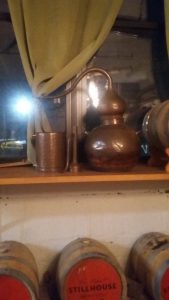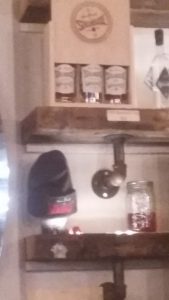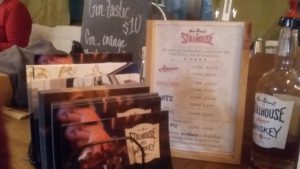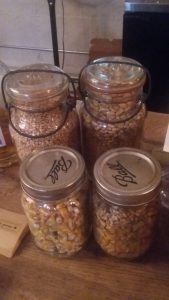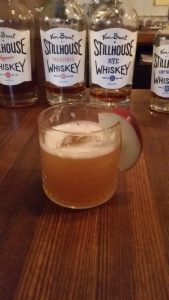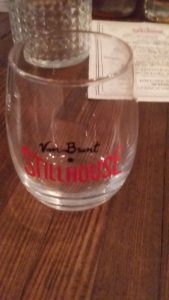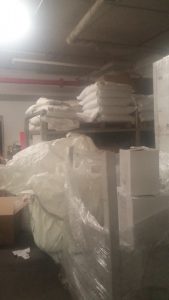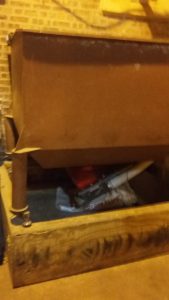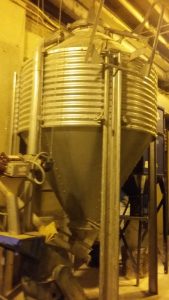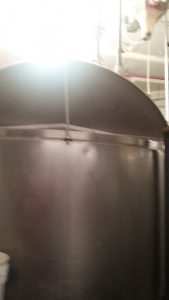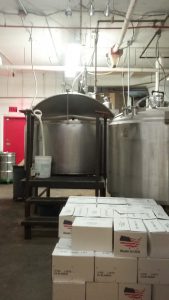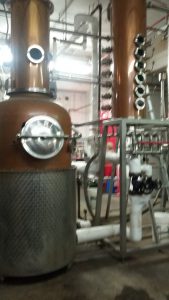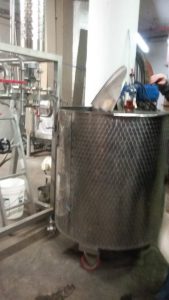I heard from the Van Brunt Stillhouse Distillery from a peer. I did some research and found that they make Whiskey, Grappa, Moonshine and Due North Rum. In a 2013 Fall issue of MicroShiner magazine, they had a piece on Van Brunt Stillhouse where they explained the name of the company. Apparently the founders wanted to come up with a name that represented the history of distilling in Brooklyn. So they thought of naming it Van Brunt after Cornelius Van Brunt, an early settler and founder of Brooklyn.
I made reservations for a tour at the distillery. I arrived by cab at 6 Bay Street in Red Hook, Brooklyn, New York. I entered this warehouse in Redhook, Brooklyn. The door had a computer printed sign that said Van Brunt Stillhouse Tasting Room and Tours. Seemed a little sketchy especially since it was really dark before 6pm. There were staircases going up and down and a big red door proper open. I went towards the door and saw an office space, wooden barrels, and sliding doors labeled, “Tasting Room. “No one to come greet us at the door and no idea where to wait for tours I went into the tasting room which showed signs of life. It was a cozy little place with uncovered low yellow light lightbulbs. A bar to the right, some counters to the left, some couches in the middle and an electronic fireplace in the far corner and wooden floors. By the window I saw a traditional single batch pot still, like the one we saw in the American History Channel video during class. I saw that the sliding doors were sliding stable doors you find in barns. I guess this is a city way of attempting to recreate barn-country chic.
The bar tender Josh wore a black t-shirt with the Van Brunt Logo, silver-framed glasses, medium length chestnut hair, and a rugged trimmed beard. He looked like a good-looking nerd on steroids. He offered a seat at the bar and if I wanted any samples or drinks. There were bottles of whiskeys on the bar counter; American, Bourbon, Rye, Moonshine, Smoked Corn and Empire. Empire I had guessed meant that it was made in New York-the Empire State. I tried the Whiskey Cider, which had a little lemon juice and to my surprise, it tasted like a mellowed-out Whiskey Sour. It was a perfect balance of cider, that was not too sweet or acidic, and their American Whiskey. As we waited for the 6 o’clock tour to start, I looked at the spirits they have on the shelves on the wall. They have their Van Brunt Stillhouse Whiskeys and some draped with medals they’ve won. They displayed their gift box set that holds 2 bottles of whiskey, there was a “Van Brunt Stillhouse” beanie, bottles with clear liquid with a strip of masking tape and on it was written “Gin.” I overheard another guest ask about the gin and the bartender said that they made their own gin and that they are going to start selling it in the near future. On the counter there were card flyers that had recipes for some beverages they make with their spirits and a map that shows where they are located. And there were jars filled with grains that they use.
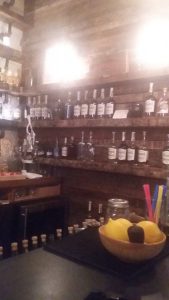
Bottles of the spirits they make, medals that they have won on the bottles to the right, and the gin they make in the middle of the bottom shelf.
A woman in her Mid-to-late 20’s came with coiffed short brown hair with neat fade hair lines on the sides and back. She wore straight-cut jeans, a gray t-shirt and gray hoodie. He blue eyes looked stoney, almost cold, but with a sense of wisdom. She introduced herself as Rachel the Tour Guide. The tour began right in front of the tasting room where small barrels laid stacked. The distillery is small, and you can see that this facility has reached full capacity with the rows of barrels, packing/labeling area, office space, and machinery all in sight. She had a bottle of their American Whiskey already there and she handed us small tasting glasses with their brand on it. To smell and taste the whiskey she said, “I’m gonna breathe through my nose, but with my mouth open a little bit, that gives the alcohol somewhere to go so that you get a little more of the aroma. As you taste it you can let it travel through all the different parts of your mouth…similar to wine, you pick up different flavors from different parts of your taste buds. As you swallow you’re going to have a little bit of a burn, it is whiskey. After that burn it’s gonna rise forward with some more flavors on your tongue.” She said that this particular whiskey was made of equal parts wheat and malted barley with the addition of rye and corn for flavor. Rachel said that pre-commercialized whiskey was made in farms from left over grains and corn that could not be commercialized to then either sell or consume. She showed us the big sacks of grains they receive from Oechsner Farms, a “transitional” organic farm located by the Finger Lakes.
Because some of the newly purchased farms is not yet certified as an organic farm, the stillhouse does not have to pay all these fees as they would from a certified farm. The Wheat, Rye and Corn grains are from Oechsner Farms, but, “[The] Malt is sourced in a variety of different places, so you won’t actually get to taste our Single Malt Whiskey because it is not a farm product. As long as our distillery operations are over a certain threshold-75% of farm ingredients, than we can make additional spirits. So we actually make a [Due North] Rum that is not a farm product, we make Tokki Soju which is like a Korean rice based spirit. Unfortunately the law for our tasting space is not the same as the law for our production so those spirits all have to be farm spirits.” This is but a brief section of the extended law and regulations of the New York State Alcohol Beverage Control. To be more specific it is under Article 5 Sub Section 61 2-C(i),
“Only liquor manufactured primarily from farm and food products, as defined in subdivision two of section two hundred eighty-two of the agriculture and markets law, shall be used in the tastings.”
Rachel then pointed to a fire engine red metal box mounted on the wall with a key lock installed. It looked like an oversized mail box you find installed by the door of a house. She said that inside is where they keep the recipes to all of their liquors. All of the recipes are done by weight. She showed us their mill which was located outside. First the grain goes into the large container where it is weighed to scale a ton of grain for the recipe.
It is ground in the mill to a size she describes as grits. She continued to talk about the fermentation process, “We’re taking a starch and we are breaching the hull, breaking it open, we’re gonna add water to it, cook it down to a sugar solution. And then we’re gonna add yeast, which eats sugar and creates alcohol.” The grist travels through the pvc pipe and goes back inside of the building, into a large vessel you have to go up some steps to reach the top. It was at this point that the second whiskey was sampled; the Bourbon. She explained that Bourbon is native to America and it has the same four grains as the American Whiskey, but it contains 55% corn. To be labeled Bourbon, “It has to be 51 percent corn, so you are going to have more sweetness…you’re also going to have to age it in new, never been used American Oak barrels, we actually do that for most of our whiskeys here. It has to be made in the United States.” She explained that bourbon can be made anywhere in the United States, “not just in Kentucky,” and like Kentucky and their Kentucky Straight, New York has its own categorization called Empire-Rye. It has to be made from 75% New York grains, distilled in New York, have to be distilled at no higher than 160 proof, put in a barrel at no higher than 115 proof, and aged for at least two years. Both are destination based like an appellation.
Through my research I found that the Empire-Rye just started last year when six leading distilleries in New York came together to create the Empire Rye Whiskey Association, dedicated to establishing a whisky style from New York that is high quality. The Van Brunt Stillhouse is the first outside distillery that has adopted this appellation standard.
Back to the vessel, the grist is boiled for 8-16 hours, depending on the recipe, and the sugar content is constantly checked on until it reaches a certain level based on the recipe. Then the grist mixture cools so that it the yeast can ferment into wort. The wort is put into a copper kettle, a Bavarian Brandy Still (which they named Jolene) that has a single column still. The column has 6 little windows where you can see all the levels where the mash travels when heated up and the alcohol evaporates further through the machine where the coils cool down the gas which becomes liquid whiskey. The mash falls down into a small vat where it collects. The mash is put through a separator where the grain is collected for New York compost to collect and the water drains into the sewer. The liquor is collected in a large vat.
Rachel said that it is distilled twice. The first is called a “stripping run” which is the initial separation of the mash and a liquid alcohol they call “low wines.” The second distillation is called the “spirit run” which she explained as the process that can separate certain compounds from the low wines at different temperatures. “We have the heads, the hearts and the tails of that spirit run, so in the spirit run of the head section, we’re gonna get stuff like methanol. We don’t really want that. That’s not one of the alcohol compounds that we’re gonna want to take into our collection, so that were actually gonna either use for cleaning in the bar or we’re gonna dilute and just dispose of…The middle part, the hearts, that’s really the collection we’re looking to reserve.” She guided us to a large vat next the Bavarian Brandy Still that was no higher than five feet. In it there was a crystal clear liquid which is a highly refined which she said was about 150 proof. Based on our lecture in class, I asked if this was moonshine, and she said yes because it was rye that they distilled earlier. We then sampled their Van Brunt Rye Whiskey which is 75% Rye which is a United States requirement they abide by to be able to label this whiskey as Rye Whiskey. It was spicy and smooth as it went down.
The last part of the whiskey making process, is putting into new white oak barrels that are about 3 feet tall. These are small barrels that they purposefully choose because of space and to accelerate the aging process so there is more liquor to charred oak contact. In doing so the quality of the whiskeys is attained it still gets that smoky flavor and deep color within the two years that it is aged. Two years is good enough for them and the Rye Whiskey Association, but they also want to specialize in young whiskey. She showed us a white oak stave from an old barrel they used to age whiskey. You can see how deeply charred the barrels are and Rachel pointed out the line where the whiskey seeped through. The barrels are purchased charred, and it acts as a natural filter as it seeps through the staves which gives the whiskey its caramel color and oaky taste. The station where they label their bottles was simple.
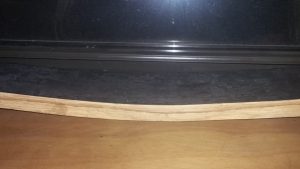
An old stave that shows the charred inside of a barrel and the line in the middle is the indicatorof how far the whiskey seeps in.
A long table, a roll of stickers, empty bottles and shelves. I could see some different shaped bottles which Rachel said were what they made for the bar such as Vermouth and Gin. This place really does what they can with what little space they have, and hope to expand. Although they plan to get a bigger place to work, this won’t change their original passion for representing young whiskey and bringing back New York’s lost grain-distilling history.
Beverage Control. Retrieved December 03, 2017, from https://www.nysenate.gov/legislation/laws/ABC/61
Empire Rye Whiskey Association. History. Retrieved December 03, 2017, from https://www.empirerye.com/history
Lyon, M. (2013, October). Van Brunt Stillhouse-History of Spirits in Red Hook, Brooklyn. MicroShiner, (Fall), 46-64. Retrieved December 03, 2017, from https://issuu.com/microshiner/docs/microshiner_autumn13_web
New York (State)., Office of the New York State Senate., Division of State Services. Alcoholic. Retrieved December 03, 2017,
Van Brunt Stillhouse. Retrieved December 03, 2017, from http://www.vanbruntstillhouse.com/

